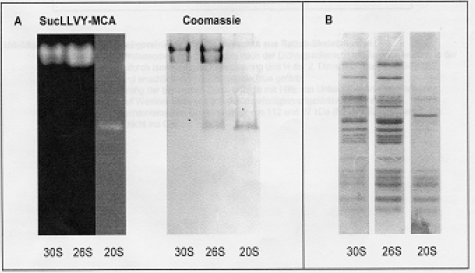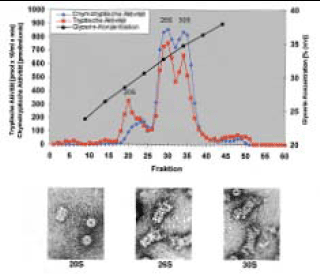Highly purified preparation of ‘26S’ proteasomes useful for carrying out in vitro protein degradation studies with suitably ubiquitinylated protein substrates.
Product Details
| Source: | Isolated from human erythrocytes. Consists of a high purity mixture of ‘26S’ proteasomes singly (26S) and doubly (30S) capped with 19S regulatory subunit complexes in the ratio of 40% single cap : 60% double capped at the time of preparation. |
| |
| Formulation: | Suspended in TSD buffer (50μg in 10mM TRIS, containing 25mM potassium chloride, 1.1mM magnesium chloride, 0.1mM ethylenediaminetetraacetic acid, 1mM dithiothreitol, 1mM sodium azide, 2mM ATP, pH 7.0, and 35% glycerol). |
| |
| Shipping: | Dry Ice |
| |
| Long Term Storage: | -80°C |
| |
| Use/Stability: | When ready for use the enzyme should be thawed by standing on ice. If the enzymatic acitivity of the 26S proteasome is to be measured, it should be used immediately after thawing since the enzyme complex is labile. After dissociaton of the 26S complex the 20S proteasome activity is relatively stable. |
| |
| Regulatory Status: | RUO - Research Use Only |
| |

A - Typical results from substrate overlay (carried out in buffer containing ATP and an ATP-regenerating system) and Coomassie staining of non denaturing gel of products isolated according to the purification shown alongside. Protein concentration is ~15-20µg per lane.. B – Coomassie staining of denaturing gel showing presence of proteasomal subunits.

A typical example of a sucrose density gradient separation and purification of 20S, 26S and 30S proteasome derived from human erythrocytes together with electron micrographs of the individual complexes. The protein concentration used for micrography is best at ~2.5µg/mL.
Please mouse over
Product Literature References
Genetic and pharmacologic proteasome augmentation ameliorates Alzheimer’s-like pathology in mouse and fly APP overexpression models: E.S. Chocron, et al.; Sci. Adv.
8, abk2252 (2022),
Abstract;
Reaction of complement factors and proteasomes in experimental encephalitis: S. Lange, et al.; J. Neurovirol.
23, 313 (2017),
Abstract;
Full Text
Structural Basis for the Inhibitory Effects of Ubistatins in the Ubiquitin-Proteasome Pathway: M.A. Nakasone, et al.; Structure
25, 1839 (2017),
Abstract;
Full Text
Dietary apigenin potentiates the inhibitory effect of interferon-α on cancer cell viability through inhibition of 26S proteasome-mediated interferon receptor degradation: S. Li, et al.; Food Nutr. Res.
60, 31288 (2016),
Application(s): Cell culture and cell-based assay,
Abstract;
Full Text
Proteolysis targeting peptide (PROTAP) strategy for protein ubiquitination and degradation: J. Zheng, et al.; Biochem. Biophys. Res. Commun.
470, 936 (2016),
Abstract;
Identification of nitric oxide as an endogenous inhibitor of 26S proteasomes in vascular endothelial cells: H. Liu, et al.; PLoS One.
9, e98486 (2014),
Abstract;
Full Text
Reconstitution of hybrid proteasomes from purified PA700-20 S complexes and PA28alphabeta activator: ultrastructure and peptidase activities: F. Kopp et al.; J. Mol. Biol.
313, 465 (2001),
Abstract;
Studies on the activation by ATP of the 26 S proteasome complex from rat skeletal muscle: B. Dahlmann et al.; Biochem. J.
309 , 195 (1995),
Abstract;














